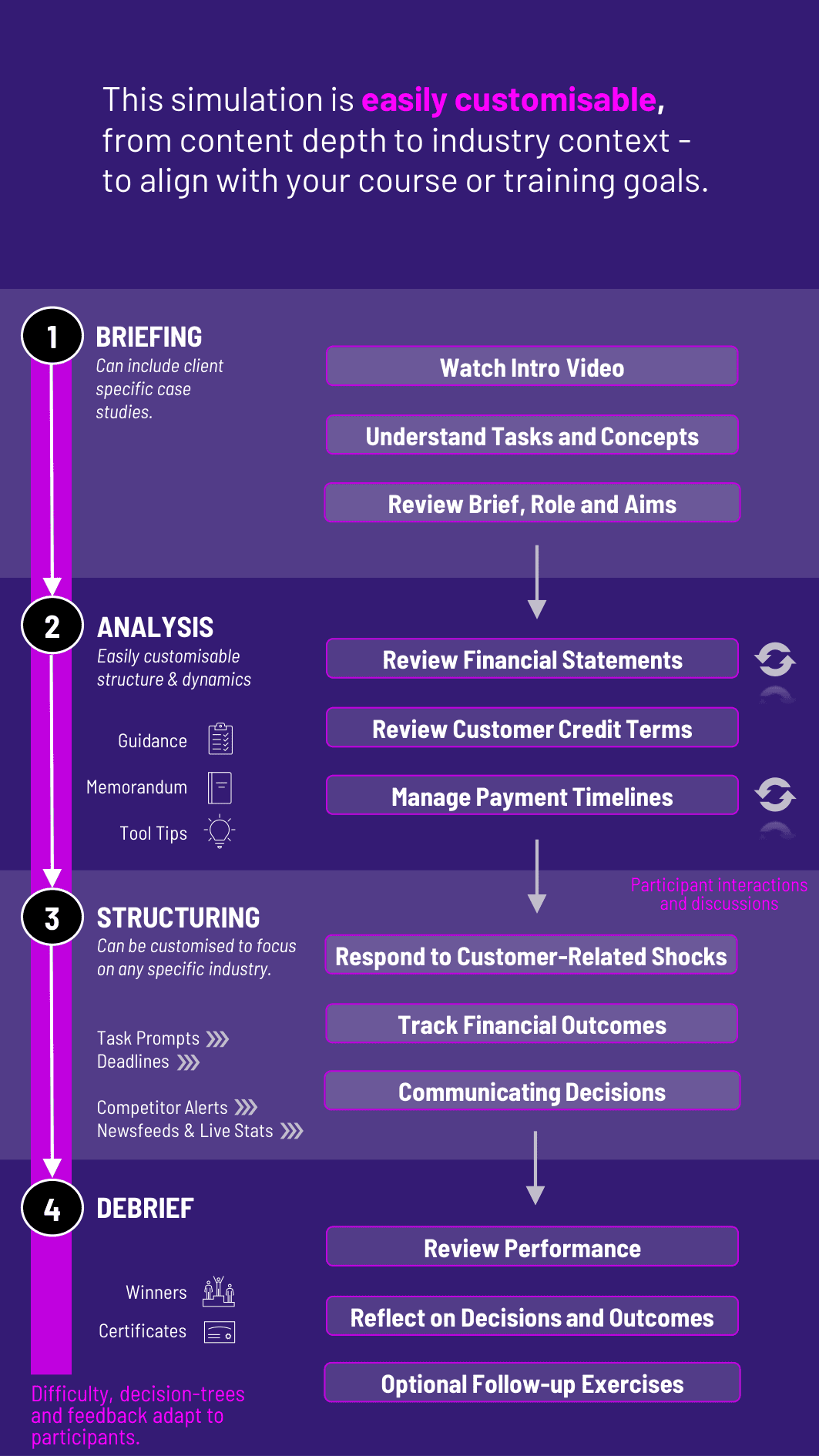
In this hands-on Working Capital Management Simulation, participants are financial decision-makers responsible for managing liquidity, improving cash flow, and balancing operational efficiency.
Cash Conversion Cycle: Interplay of inventory, receivables, and payables
Accounts Receivable: Credit policies, collections, and DSO
Inventory Management: EOQ, safety stock, and stockout risk
Accounts Payable: Payment terms, supplier negotiations, and DPO
Liquidity Management: Cash forecasting and short-term funding
Cost of Capital: Trade-offs between liquidity and profitability
Crisis Response: Managing disruptions in supply, demand, or credit
Stakeholder Communication: Justifying changes to procurement, sales, or operations teams


Reviewing cash flow statements, working capital ratios, and performance metrics
Adjusting credit terms for customers to influence receivables
Managing payment timelines with suppliers
Deciding how much inventory to hold across product lines
Responding to unexpected shocks (e.g. customer default, supplier delay)
Communicating decisions to sales, operations, and senior management
Tracking outcomes such as free cash flow, customer satisfaction, and supplier stability
Revising policies to meet evolving targets across simulation rounds
By the end of the simulation, participants will:
Understand how operational decisions affect cash flow and financial health
Learn to calculate and optimize the cash conversion cycle
Gain fluency in liquidity metrics like DSO, DPO, and inventory turnover
Balance competing priorities (growth vs. cash preservation, sales vs. credit risk)
Learn how to negotiate better terms with suppliers and customers
See how external events (macroeconomic shifts, seasonality) affect short-term financing needs
Communicate finance decisions effectively across business functions
Apply working capital knowledge in a strategic, cross-functional context
This simulation is ideal for students in finance, accounting, and operations, as well as professionals in treasury, FP&A, or supply chain roles.
1. Receive Company Brief and Objectives Each round begins with a scenario: declining cash flow, supplier delays, growing sales pipeline, or unexpected expenses.
2. Analyze Metrics and Risk Participants review key indicators - current ratios, turnover metrics, projected liquidity gaps - and assess risks and opportunities.
3. Make Strategic Adjustments They fine-tune payment terms, credit policies, inventory holdings, and purchasing strategies based on priorities.
4. Evaluate Results The simulation calculates the effects of their decisions on financial performance and stakeholder sentiment.
5. Communicate and Justify Participants must explain their logic in team discussions, board memos, or stakeholder presentations.
6. Adapt in Subsequent Rounds New developments (e.g. interest rate changes, supplier exits, customer churn) challenge participants to evolve their approach.
Do I need accounting experience? Basic familiarity with balance sheet and cash flow concepts helps, but the simulation is beginner-friendly and fully guided.
Can the simulation be tailored to industries? Yes. The business scenarios can be adapted to fit manufacturing, retail, consumer goods, or services.
Does it include real financial ratios? Yes. Participants work directly with ratios like DSO, DPO, inventory turnover, current ratio, and cash conversion cycle.
Is this a solo or team simulation? It works well both ways. Teams can represent different departments or divisions within a company.
Can I use this in an operations course? Absolutely. The cross-functional nature of working capital makes it ideal for both finance and operations programs.
How long does the simulation last? It can run in 90 minutes to 3 hours, or over multiple sessions with deeper analysis and peer learning.
How is performance measured? Participants are assessed on liquidity improvement, stakeholder alignment, risk management, and ability to justify decisions.
Is this good for professionals too? Yes. It’s an excellent simulation for treasury, procurement, sales ops, and FP&A teams.
Does it simulate crises? Yes. Each round introduces new variables - from economic downturns to supplier strikes and inventory shortages.
Is the simulation competitive? It can be. Teams can compare outcomes, benchmark decisions, and compete for optimal working capital performance.
Financial performance (cash flow, liquidity ratios, working capital turnover)
Strategic alignment of their decisions
Justification and communication of trade-offs
Team collaboration and stakeholder negotiation
Adaptability in response to new conditions
Written or verbal presentation quality (e.g., CFO memo or stakeholder debrief)
Optional components like reflection essays or group presentations can also be included for deeper learning.
Join this 20-minute webinar, followed by a Q&A session, to immerse yourself in the simulation.
or
Book a 15-minute Zoom demo with one of our experts to explore how the simulation can benefit you.